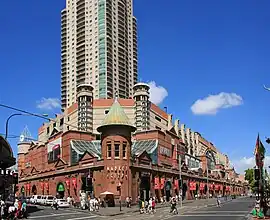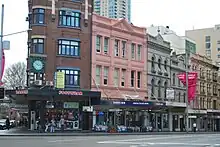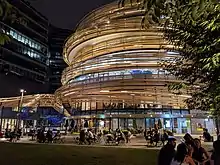Haymarket, New South Wales
Haymarket is an inner city suburb of Sydney, New South Wales, Australia. It is located at the southern end of the Sydney central business district in the local government area of the City of Sydney. Haymarket includes much of Sydney's Chinatown, Thaitown and Railway Square localities. Haymarket is adjacent to Darling Harbour and is surrounded by the suburbs of Ultimo, Chippendale, Surry Hills and the Sydney CBD.
| Haymarket Sydney, New South Wales | |||||||||||||||
|---|---|---|---|---|---|---|---|---|---|---|---|---|---|---|---|
 Sydney Market City building | |||||||||||||||
| Population | 8,305 (SAL 2021)[1] | ||||||||||||||
| Postcode(s) | 2000 | ||||||||||||||
| Area | 0.4 km2 (0.2 sq mi) | ||||||||||||||
| LGA(s) | City of Sydney | ||||||||||||||
| State electorate(s) | Sydney | ||||||||||||||
| Federal division(s) | Sydney | ||||||||||||||
| |||||||||||||||
History

Sydney's produce markets were located in Haymarket from the early 20th century through to the 1980s when they were moved to a new site at Flemington. Paddy's Markets still operate on part of the site of the vegetable markets as a produce and flea market. The 'Market City' complex contains the markets, The Peak apartment building, a modern shopping centre featuring a food court, restaurants, boutiques, specialty shops and entertainment options, such as a cinema and amusement centre.
The outer walls of the original vegetable market, built in 1909, were preserved and restored as an example of Edwardian architecture. They were part of the original city markets—designed by city architect C.Broderick—which were bounded by Hay Street, Quay Street and Thomas Street. They were built to replace the old Belmore Market, which had failed because it was too far from Darling Harbour.
The new markets included the Sydney City Markets building (Ultimo Road), designed by George McRae and built in 1910, and the Sydney Markets Bell Tower (Quay Street), built in 1911 and restored by the State Bank in 1985. The bell tower is now incorporated within the University of Technology Sydney.[2]
By the 1920s, Sydney's "Chinatown" had moved to Haymarket from the Rocks and Market Street near Darling Harbour. Haymarket became a commercial and community centre for the Chinese community who lived in large numbers in this area and nearby areas such as Surry Hills.[3] With the relocation of the produce market to Flemington and outflow of residents to the suburbs, the commercial role of Haymarket declined. The City of Sydney authorities embarked on a project to establish Haymarket as a tourist-oriented Chinatown. In the 1980s, Dixon Street was pedestrianised, and nearby redevelopments were steered towards creating the atmosphere of an "authentic" Chinatown. This included the construction of Chinese paifang-style gates, with stone lions, on Dixon Street, and other Chinese-style street furniture, as well as encouraging Chinese restaurants to open along Dixon Street. Despite significant demographic change due to successive waves of immigration from Asia, today's Chinatown remains a centre for Asian restaurants and other businesses.
The Capitol Theatre, built in 1928, is also located in Haymarket.
Heritage listings
Haymarket has a number of heritage-listed sites, including:
- 17 Little Pier Street: Hydraulic Pump Station[4]
- 181–187 Hay Street: 181-187 Hay Street (the Corporation Building),[5] which houses 4A Centre for Contemporary Asian Art[6][7]
Population

| Year | Pop. | ±% |
|---|---|---|
| 2001 | 5,091 | — |
| 2006 | 4,312 | −15.3% |
| 2011 | 5,376 | +24.7% |
| 2016 | 7,353 | +36.8% |
| 2021 | 8,305 | +12.9% |
According to the 2021 census, the population of Haymarket had increased to 8,305.[8]
At the 2016 census, there were 7,353 residents in Haymarket. The median age was 27 years and 49.7% of people were aged 20–29 years. More than half of Haymarket residents were attending an educational institution, with the majority of these people attending a tertiary or technical institution. Just 8.3% of residents were born in Australia.[9] 87.8% of the population was foreign born in 2011, the highest for any Australian suburb.[10] The most common other countries of birth were Thailand 20.7%, China 18.9%, Indonesia 11.5%, Korea, Republic of (South) 5.0% and Vietnam 2.1%. 71.6% of people spoke a language other than English at home. The main languages spoken were Thai 20.4%, Mandarin 20.3%, Indonesian 10.2%, Cantonese 5.1% and Korean 4.8%. The most common responses for religion were No Religion 33.2% and Buddhism 30.5%. 99.8% of dwellings were flats, units or apartments. 47.8% of households renting their accommodation were paying more than 30% of household income as rent, compared to the NSW average of 12.9% and the Australian average of 11.5%.[9]
Transport
Central railway station sits on the southern border.
Haymarket is also serviced by the Dulwich Hill Line of Sydney's light rail network with stations at Central, Capitol Square and Paddy's Markets. The light rail uses a former freight rail corridor. A short section is not used by the light rail having been converted to The Goods Line pedestrian link to Railway Square and Central station. It is also served by the CBD and South East Light Rail with a stop at Chinatown and Haymarket.
Gallery
 Darling Square
Darling Square Little Hay Street at night
Little Hay Street at night Aarons Hotel, formerly City Markets
Aarons Hotel, formerly City Markets Vegetable market building, Hay Street
Vegetable market building, Hay Street City markets bell tower, Quay Street
City markets bell tower, Quay Street Market City
Market City Hay St, view toward George Street
Hay St, view toward George Street
References
- Australian Bureau of Statistics (28 June 2022). "Haymarket (Suburb and Locality)". Australian Census 2021 QuickStats. Retrieved 28 June 2022.
- Sydney Architecture, John Haskell (UNSW Press) 1997, p.55
- Sharpe, Alan (2000). City of Sydney: Pictorial History. Kingsclear Books. ISBN 9-780-98718408-5.
- "Hydraulic Pump Station (former)". New South Wales State Heritage Register. Department of Planning & Environment. H00125. Retrieved 18 May 2018.
 Text is licensed by State of New South Wales (Department of Planning and Environment) under CC-BY 4.0 licence.
Text is licensed by State of New South Wales (Department of Planning and Environment) under CC-BY 4.0 licence. - "Municipal Building". New South Wales State Heritage Register. Department of Planning & Environment. H00693. Retrieved 13 October 2018.
 Text is licensed by State of New South Wales (Department of Planning and Environment) under CC-BY 4.0 licence.
Text is licensed by State of New South Wales (Department of Planning and Environment) under CC-BY 4.0 licence. - "History". 4A Centre for Contemporary Asian Art. Retrieved 22 September 2021.
- "Defining Moments: Founding of Gallery 4A". Australian Centre for Contemporary Art. Retrieved 22 September 2021.
- "2021 Haymarket, Census All persons QuickStats". Australian Bureau of Statistics. Retrieved 19 August 2022.
- Australian Bureau of Statistics (27 June 2017). "Haymarket (State Suburb)". 2016 Census QuickStats. Retrieved 29 June 2017.
- "Where do migrants live? (4102.0 - Australian Social Trends, 2014)". Australian Bureau of Statistics. 17 March 2014. Retrieved 20 March 2014.
External links
- Shirley Fitzgerald (2009). "Haymarket". Dictionary of Sydney. Retrieved 27 September 2015. [CC BY-SA]
- 4A Centre for Contemporary Asian Art